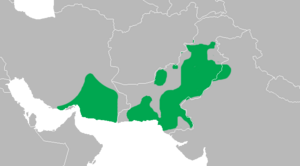Sind woodpecker facts for kids
Quick facts for kids Sind woodpecker |
|
|---|---|
 |
|
| Conservation status | |
| Scientific classification | |
| Genus: |
Dendrocopos
|
| Species: |
assimilis
|
 |
|
The Sind woodpecker (scientific name: Dendrocopos assimilis) is a type of bird. It belongs to the Picidae family, which includes all woodpeckers. This bird lives in Sindh province in Pakistan, parts of India, and southern Iran.
Contents
What Does It Look Like?
The Sind woodpecker looks a bit like the Syrian woodpecker. However, the Sind woodpecker is smaller. It has a thin "mustache" stripe and a lot of white feathers on its back. Its beak is also smaller. You can spot white patches on its shoulders and white stripes on its black feathers. It is the only black and white woodpecker in the areas where it lives.
Where Does It Live and What Does It Eat?
The Sind woodpecker is a resident bird, meaning it stays in one place. It is found in Sindh in Pakistan, India, and southern Iran. These birds like forests, but they can also live in gardens and farms. You can find them up to 2,200 meters high.
Favorite Habitats
They naturally live in warm, dry forests and forests near rivers. They also like thorny bushes, dry scrublands, and wet areas like freshwater springs and oases. These woodpeckers do not migrate. Most young birds simply move to new areas after they grow up.
What's on the Menu?
The Sind woodpecker mainly eats insects. This includes insects that bore into wood, their young (larvae), spiders, and ants.
Reproduction and Life Cycle
The breeding season for Sind woodpeckers is usually in March and April. These birds are monogamous. This means that a male and female pair up and stay together to raise their young.
Nesting and Chicks
They make their nests in holes they dig in trees. The female usually lays about 3 to 5 eggs. Both parents take turns sitting on the eggs to keep them warm. The eggs hatch after about 12 days. The baby birds, called chicks, are ready to fly after about 20 days. Once they can fly, the young birds leave their parents to find new places to live.
How Is Its Population Doing?
Scientists have not yet fully counted the global population of the Sind woodpecker. However, the number of these birds seems to be stable. In most places where it lives, the Sind woodpecker is quite common.
Threats to the Sind Woodpecker
A Sind woodpecker usually lives for about 5.2 years. The area where it lives covers about 1,490,000 square kilometers. The biggest danger to the Sind woodpecker is deforestation. This is when forests are cut down, which destroys the places where these birds live and find food.


